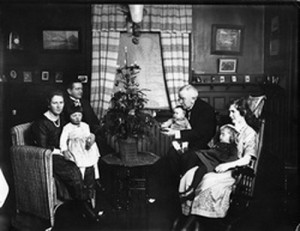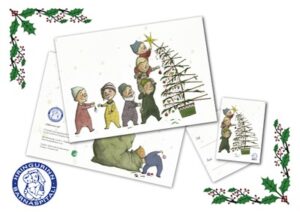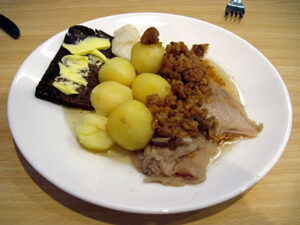Christmas in Iceland
Christmas is taken very seriously in Iceland..
The whole house is cleaned, everyone gets something new to wear, people buy the best food, decorate the house inside and out and bake hundreds of cookies. It is truly a feast of the senses.
Families get together, enjoy good food and exchange presents. It is Iceland’s longest holiday, everything is closed from noon on Christmas Eve until December 27.
Unlike North America, Icelanders celebrate on Christmas Eve. The family gets together in the evening and that is when presents are exchanged. During the following two days everyone goes to Christmas parties and meets with grandparents, uncles, aunts, cousins and friends.
History of Christmas in Iceland
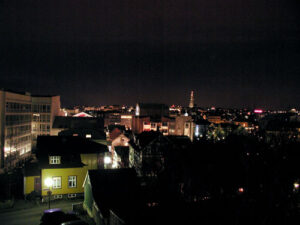 Long before Christianity was introduced, people in Northern Europe celebrated winter solstice which ushers in gradually lengthening days. In Iceland, winter solstice celebrations were grand events. Landowners would invite many people to their house and people would feast and drink extravagantly. After the adoption of Christianity in the year 1000 in Iceland, this celebration was integrated with the Christian Christmas Celebration. Thus, Icelandic Christmas are historically two celebrations: Celebrating the birth of Christ and celebrating the beginning of the lengthening daylight hours.
Long before Christianity was introduced, people in Northern Europe celebrated winter solstice which ushers in gradually lengthening days. In Iceland, winter solstice celebrations were grand events. Landowners would invite many people to their house and people would feast and drink extravagantly. After the adoption of Christianity in the year 1000 in Iceland, this celebration was integrated with the Christian Christmas Celebration. Thus, Icelandic Christmas are historically two celebrations: Celebrating the birth of Christ and celebrating the beginning of the lengthening daylight hours.
The Icelandic word for Christmas, Jól, contains no reference to Christ or to the church. It is a Norse word and also existed in Old English as Yule.
Icelanders celebrate Christmas in the evening of December 24 and this custom is thought to be a development from an old Catholic custom where people would have a wake the night before big church holidays as it was often believed that a new day started at 6 p.m., which is when Icelanders traditionally either go to church or begin the festivities at their home.
Icelanders celebrate 13 days of Christmas. The period starts on December 24 and ends on January 6, which is when all Christmas decorations are removed from streets and houses. This traditions is believed to extend back to the 4th and 5th centuries in Europe where the birth of Christ was celebrated on December 25th and his christening and the three wise men were celebrated on January 6.
Christmas Decorations and Preparations
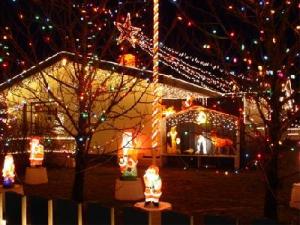
http://vedistravel.wordpress.com/2011/12/24/gledileg-jol-merry-christmas-glaedelig-jul-feliz-navidad/
Icelanders take their Christmas decorating very seriously. Everyone decorates. The most common decoration are Christmas trees which are almost universal in Iceland. The trees are decorated in similar manner to the United States, i.e. with lights, garland, ornaments etc. Live trees are still the norm although in recent years more and more people have been exchanging them for artificial ones. Before the use of pine trees as Christmas trees was introduced in Iceland in the 19th century, most Christmas trees were homemade. They pine tree gradually took over and became predominant in Iceland during World War II. The original decorations included candles, fruit (apples, oranges) as ornaments and garland made out of popcorn or cranberries. Sometimes even the presents were hung on the trees as decorations and tiny wrapped boxes are still popular as homemade ornaments.
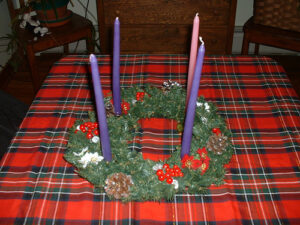 Another common Christmas decoration is the Advent light. There are two different types of Advent lights in Iceland, both very popular. One is the Advent wreath, which has four candles, one for each Sunday of the Advent. This custom orgininated in Germany and was first seen in Iceland in the 1930s. It became widely popular in the 60s and 70s. The other type of Advent light are seven candles arranged in a triangle-shaped candelabra. These are mostly electric light nowadays. They are very popular and many families have more then one. They are usually put onto a window sill and are lit from the first Sunday of the Advent and until January 6.
Another common Christmas decoration is the Advent light. There are two different types of Advent lights in Iceland, both very popular. One is the Advent wreath, which has four candles, one for each Sunday of the Advent. This custom orgininated in Germany and was first seen in Iceland in the 1930s. It became widely popular in the 60s and 70s. The other type of Advent light are seven candles arranged in a triangle-shaped candelabra. These are mostly electric light nowadays. They are very popular and many families have more then one. They are usually put onto a window sill and are lit from the first Sunday of the Advent and until January 6.
Icelanders have also adopted many other traditions and customs familiar to Americans. They include Christmas lights indoors and out, santas, reindeer, wreaths etc. Icelanders usually do not go to the same extremes as can be seen widely in the U.S. with lights all around the house and live size decorations in their yards, although in recent years a few homes have been decorating their houses in this mannes, usually attracting a lot of attention and even media coverage.
Sending Christmas cards is an important tradition in Iceland. People send cards to their more distant relatives and friends and even children send cards to their friends. It is very important not to leave anyone out, especially of that person sent you a card last year. Many families send dozens of cards each Christmas and receive dozens of cards in turn. This is sometimes the only correspondance between distant friends or family members and they often include more in the card than just a Christmas greeting. It is traditional to at least thank for the year that is about to pass and, more often than not, a comment about seeing each other more often in the new year is included. Or, if people live far away, they may mention that everyone in the family is well and something special that has happened in the past year. One never uses Christmas cards for anything but happy news and wishes.
Þorláksmessa – St. Þorlákur’s Mass
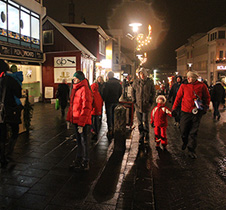 Þorláksmessa is the day before Christmas, or December 23rd. It is generally the biggest shopping day in Iceland as people run to the stores in a frenzy to get the last Christmas presents.
Þorláksmessa is the day before Christmas, or December 23rd. It is generally the biggest shopping day in Iceland as people run to the stores in a frenzy to get the last Christmas presents.
Þorláksmessa is named after Þorlákur Þórhallsson, a priest in Iceland in the 12th century. He died on this day in 1193. He was canonized by Althingi (the Icelandic Parliament) in 1198. There are two feastdays of Þorlákur, December 23rd is one and July 20th is the other.
The dish of the day is skate. The reason for this is that it is the last day of the Christmas fast and no one was supposed to eat meat. The skate is pickled and putrefyed because, much like shark, skate has enzymes that can be harmful when consumed fresh. It is served mostly with boiled potatoes. The tradition of eating skate on December 23rd is still very popular in Iceland despite the strong smell of ammonia that comes from the pickling and putrefying of the fish. However, many go to restaurants to enjoy the food so as not to introduce the smell into the house.
Children Come First
Church holidays, especially Easter and Christmas, have become an important strand in the social fabric of Iceland. As in many other countries, Icelandic Christmas is centered around children. For example, Christmas is not seen as an occasion for drinking alcohol. Families get together, enjoy good food, dress up in their best clothes and spend time with each other. Christmas, more than any other time of the year, is when Icelanders abroad travel home to be with their families.
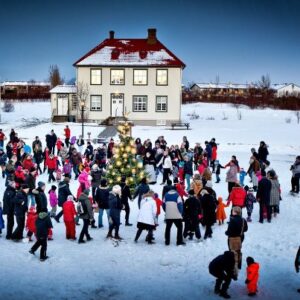 Children get around 2-3 weeks of Christmas holidays. In elementary and middle school, the last day of school before Christmas is called “small Christmas”. On this day, children bring cookies and sodas to school, light candles in their previously decorated classrooms, sing Christmas carols and sometimes even dance around a Christmas tree. This tradition is so popular with elementary schoolchildren that many of them have insisted on continuing this in high school and they decorate their classrooms and spend the day walking from classroom to classroom, admiring each other’s handiwork. Although some teachers still insist on having classes this last day of school, much to the dismay of their students, this day is gradually becoming more of a holiday and less of a schoolday.
Children get around 2-3 weeks of Christmas holidays. In elementary and middle school, the last day of school before Christmas is called “small Christmas”. On this day, children bring cookies and sodas to school, light candles in their previously decorated classrooms, sing Christmas carols and sometimes even dance around a Christmas tree. This tradition is so popular with elementary schoolchildren that many of them have insisted on continuing this in high school and they decorate their classrooms and spend the day walking from classroom to classroom, admiring each other’s handiwork. Although some teachers still insist on having classes this last day of school, much to the dismay of their students, this day is gradually becoming more of a holiday and less of a schoolday.
Christmas Dinner
In centuries past, most people would slaughter a lamb and have ‘kjötsúpa’ for Christmas dinner, a meat broth with bits of meat in it. Kjötsúpa is still common in Iceland, although not as Christmas dinner. Poorer families would have ptarmigan for Christmas.
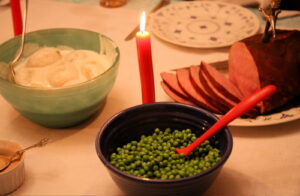 Nowadays, the most common Christmas dishes in Iceland are ham (hamborgarahryggur), smoked lamb (hangikjöt) and ptarmigan (rjúpa). Ptarmigan is no longer a food for the poor and has become very popular with Icelanders, and the ptarmigan hunting season is one of the most anticipated events of the year for hunters. These dished are lavishly prepared with side dishes including potatoes, prepared in many different ways, peas and beans, gravy, jam etc. The cook usually spends most of the day cooking, with help, of course, from other family members.
Nowadays, the most common Christmas dishes in Iceland are ham (hamborgarahryggur), smoked lamb (hangikjöt) and ptarmigan (rjúpa). Ptarmigan is no longer a food for the poor and has become very popular with Icelanders, and the ptarmigan hunting season is one of the most anticipated events of the year for hunters. These dished are lavishly prepared with side dishes including potatoes, prepared in many different ways, peas and beans, gravy, jam etc. The cook usually spends most of the day cooking, with help, of course, from other family members.
The ‘Christmas Cat’
 An old Icelandic folklore states that everyone has to get one new piece of clothing at Christmas. Anyone who was left out was in danger of being eaten by a malicious beast called the Christmas Cat. The Christmas Cat is Grýla’s cat (see Yule Lads) and every effort was made to ensure that no-one would “go to the Christmas Cat”. Thus, everyone worked very hard to make a new piece of clothing for each member of the household.
An old Icelandic folklore states that everyone has to get one new piece of clothing at Christmas. Anyone who was left out was in danger of being eaten by a malicious beast called the Christmas Cat. The Christmas Cat is Grýla’s cat (see Yule Lads) and every effort was made to ensure that no-one would “go to the Christmas Cat”. Thus, everyone worked very hard to make a new piece of clothing for each member of the household.
The first stories about the Christmas Cat arose in the 19th century and were probably aimed at lazy children. It seemes to have worked as, to this day, everyone gets a new piece of clothing either before or at Christmas.
Similar stories exist about a bull in the Baltics and about a goat in Norway.
The Yule Lads
Icelanders have not one, but thirteen Santas, or Yule Lads. These lads are not related to Santa Claus in any way. They are descendants of trolls and were originally used to scare children. In the last century, however, they have become a lot friendlier.
 The number of Yule Lads has varied throughout the centuries but now they are consistently thirteen. The number 13 was first seen in a poem in the 18th century and the names that they carry today was published in Jón Árnason’s folklore collection of 1862. Their current names are: Stekkjastaur (Sheepfold Stick), Giljagaur (Gilly Oaf), Stúfur (Shorty), Þvörusleikir (Spoon-licker), Pottasleikir (Pot-licker), Askasleikir (Bowl-licker), Hurðaskellir (Door-slammer), Skyrgámur (Skyr-glutton), Bjúgnakrækir (Sausage-pilfer), Gluggagægir (Peeper), Gáttaþefur (Sniffer), Ketkrókur (Meat-hook) and Kertasníkir (Candle-begger). As you can tell from these names, the lads are very mischievous and they have retained their unique characteristics to this day. They live in the mountains with their parents, Grýla and Leppalúði. They come to town, one by one, in the days before Christmas. The first one arrives on December 12th and the last one on December 23rd. Formerly, they tried to pilfer their favorite things or play tricks on people (hence their names), but now their main role is to give children small gifts. Every child in Iceland puts their best shoe on their bedroom window sill on December 12th (some try to put their boot, in the hope that they may get more, but so far the Yule Lads haven’t been fooled) and they get a small gift from each lad when he arrives in town. But beware not to be naughty or the lad might just leave a rotten potatoe in your shoe!
The number of Yule Lads has varied throughout the centuries but now they are consistently thirteen. The number 13 was first seen in a poem in the 18th century and the names that they carry today was published in Jón Árnason’s folklore collection of 1862. Their current names are: Stekkjastaur (Sheepfold Stick), Giljagaur (Gilly Oaf), Stúfur (Shorty), Þvörusleikir (Spoon-licker), Pottasleikir (Pot-licker), Askasleikir (Bowl-licker), Hurðaskellir (Door-slammer), Skyrgámur (Skyr-glutton), Bjúgnakrækir (Sausage-pilfer), Gluggagægir (Peeper), Gáttaþefur (Sniffer), Ketkrókur (Meat-hook) and Kertasníkir (Candle-begger). As you can tell from these names, the lads are very mischievous and they have retained their unique characteristics to this day. They live in the mountains with their parents, Grýla and Leppalúði. They come to town, one by one, in the days before Christmas. The first one arrives on December 12th and the last one on December 23rd. Formerly, they tried to pilfer their favorite things or play tricks on people (hence their names), but now their main role is to give children small gifts. Every child in Iceland puts their best shoe on their bedroom window sill on December 12th (some try to put their boot, in the hope that they may get more, but so far the Yule Lads haven’t been fooled) and they get a small gift from each lad when he arrives in town. But beware not to be naughty or the lad might just leave a rotten potatoe in your shoe!
Their original clothing are rags that are similar to farmer’s clothes in the 18th century. and they are often seen carrying their favorite food. Nowadays, however, they are usually seen in familiar red clothing with white beards and black boots.
They often make appearances at Christmas dances, which are very popular among Icelandic children. Children (adults are of course welcome to join them) dance around a Christmas tree and sing carols. The highlight of the dance is when one of the Yule Lads joins the celebration and dances and sings with the kids and usually gives them a goody bag before he leaves.
The day after Christmas the first lad returns to the mountains. Then they leave, one by one, until the last one leaves on January 6th, which is the last day of the Christmas season.
A Silent Night
The ringing of the bells of the Lutheran Cathedral in Reykjavík, broadcast nationally as the beginning of a special religious service, is a signal for all (except those in church) to embrace and wish one another a Merry Christmas. This is the formal beginning of Christmas. After that it is time for dining.
All regular public services come to a standstill on Christmas Eve. No buses are running, no restaurants or places of entertainment are open. Fishing vessels are moored in port. Even hospitals are half-empty, for patients are allowed to go home if this can be done with safety. Those who live alone visit close relations or friends; it is simply assumed that everyone wants to be a member of a family at Christmas.
Christmas Eve is the high point of the holiday season in Iceland, and the sumptuous dinner is just the beginning of the night. But what the children have been waiting for so long – the opening of packages – cannot take place until a few details have been attended to: the table has to be cleared and the dishes washed, but there are many willing hands for that. The big moment arrives when everyone is sitting comfortably in the living room. And what can be found in those beautifully wrapped packages? Interestingly, books have been among the most popular items for Christmas gifts in Iceland for decades. Parents often give their children items such as clothes, skis or related gear, CDs or books. In recent years a cell phone has been at the top of many young people’s wishlist, and many have gotten them, introducing in Iceland the age of the cell phone. There are exchanges of gifts between the children, between husbands and wives, between visiting grandparents and the younger generations. There are presents for everyone from everyone in that pile at the base of the Christmas tree. It is a cheerful scene, full of warmth and happiness.
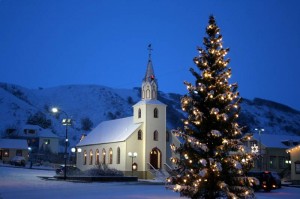 People rarely leave the house on Christmas Eve – except for going to church, and that practice is not very widespread. The streets are deserted; it is the quietest night of the year in towns, but just about every building is wearing a finery of bright lights. Many families end the evening by watching a late religious service on TV officiated by the Lutheran Bishop. If anyone happens to want some refreshments afterwards, there is plenty of home-made pastries, coffee and soft drinks. This is not a night for anything stronger.
People rarely leave the house on Christmas Eve – except for going to church, and that practice is not very widespread. The streets are deserted; it is the quietest night of the year in towns, but just about every building is wearing a finery of bright lights. Many families end the evening by watching a late religious service on TV officiated by the Lutheran Bishop. If anyone happens to want some refreshments afterwards, there is plenty of home-made pastries, coffee and soft drinks. This is not a night for anything stronger.
As a rule, people sleep late the following morning. A festive Christmas Day lunch is traditional, but there seems to be growing preference for a dinner that is the main meal. Christmas Day is typically used for visiting family. Public services remain minimal or nonexistent. Although the Second Day of Christmas (Boxing Day, December 26th) is a major holiday – celebrated, among other things, with additional family visiting – the general scene in towns and villages by then calls to mind an ordinary Sunday. Buses are running again on regular schedules, and restaurants and places of entertainment attract crowds, especially in the evening – rather larger ones than usually on Sunday: it is finally socially acceptable to “lift a glass” as they saying goes in Iceland.
New Year’s Eve
If Icelanders don’t drink on Christmas Eve, they most certainly make up for it on New Year’s Eve. New Year’s Eve is probably the biggest party night of the whole year. The most distinguishing characteristic of an Icelandic New Year’s Eve are the fireworks. Everyone buys fireworks and on this night everyone is allowed light fireworks (ususally requires special permission from the authorities). And Icelanders make sure they take full advantage of that. Fireworks are lighted all night long, reaching the high point at midnight, when the sky lights up for a few minutes as the fire trucks and harbored ships ring their bells and blow their horns to welcome the new year. It is certainly the grandest display of fireworks you will ever see. After midnight, people gather either downtown to go clubbing or at parties where they drink the night away, often until the early hours of the morning.
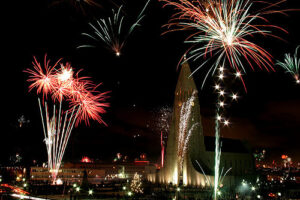 Understandably, there is usually not much activity in Iceland on New Year’s Day, except perhaps for the younger children who run out to gather the sticks from the fireworks and there is often fierce competition over who find the most.
Understandably, there is usually not much activity in Iceland on New Year’s Day, except perhaps for the younger children who run out to gather the sticks from the fireworks and there is often fierce competition over who find the most.
Þrettándinn – Last Day of Christmas
January 6th is normally referred to as þrettándinn (13th day). It is the last day of Christmas and is often referred to in English as ‘Twelfth Night’ or ‘Epiphany’. By this day, pretty much everything is back to normal; everyone is back at work and schools have started. In the evening of this day, families usually get together, have dinner, maybe light the remainder of their fireworks from New Year’s Eve and bid farewell to Christmas.
Back to Normal
Christmas decorations are taken down immediately after January 6th. Even though the coming weeks promise only a drab reality (a month will pass before the days get noticeably longer), most look ahead with a sense of renewal and confidence. Many have to be conservative with money to make up for recent overspending, but expressions of regrets are uncommon. After all, the Christmas season brought priceless experiences; a long string of bright days in the darkest of winter, good companionship and a leisurely pace of life not offered by any other season. It all comes to an end, the Christmas lights go out, signaling the return of ordinary activites. But Icelanders’ spirits remain fairly high – thanks to all the good times not so far back, and to the knowledge that the sun will rise a few minutes earlier and set a few minutes later each day.
Christmas in Icelandic
A few phrases in Icelandic:
| ChristmasMerry Christmas
Happy New Year Advent Santa Claus/Yule Lad Christmas Tree Christmas Present Christmas Card Christmas Eve Christmas Day December 26th (Boxing Day) New Year’s Eve New Year’s Day |
JólGleðileg jól
Gleðilegt ár Aðventa Jólasveinn Jólatré Jólagjöf Jólakort Aðfangadagur Jóladagur Annar í jólum Gamlaárskvöld Nýársdagur |

